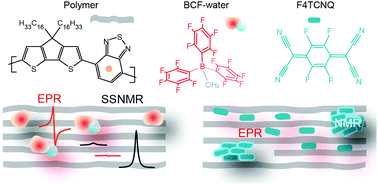Structural insights into Lewis acid- and F4TCNQ-doped conjugated polymers by solid-state magnetic resonance spectroscopy†
Abstract
Molecular doping strategies facilitate orders of magnitude enhancement in the charge carrier mobility of organic semiconductors (OSCs). Understanding the different doping mechanisms and molecular-level constraints on doping efficiency related to the material energy levels is crucial to develop versatile dopants for OSCs. Given the compositional and structural heterogeneities associated with OSC thin films, insight into dopant–polymer interactions by long-range techniques such as X-ray scattering and electron microscopy is exceedingly challenging to obtain. This study employs short-range probes, solid-state (ss)NMR and EPR spectroscopy, to resolve local structures and intermolecular interactions between dopants such as F4TCNQ (2,3,5,6-tetrafluoro-7,7,8,8-tetracyanoquinodimethane), Lewis acid BCF (tris[pentafluorophenyl] borane) and Lewis base conjugated polymer, PCPDTBT (P4) (poly[2,6-(4,4-bis(2-hexadecyl)-4H-cyclopenta[2,1-b;3,4-b′]dithiophene)-alt-4,7(2,1,3-benzothiadiazole)]). Analysis of 1H and 13C ssNMR spectra of P4, P4 : F4TCNQ and P4 : BCF blends indicates that the addition of dopants induces local structural changes in the P4 polymer, and causes paramagnetism-induced signal broadening and intensity losses. The hyperfine interactions in P4 : BCF and P4 : F4TCNQ are characterized by two-dimensional pulsed EPR spectroscopy. For P4 : F4TCNQ, 19F ssNMR analysis indicates that the F4TCNQ molecules are distributed and aggregated into different local chemical environments. By comparison, BCF molecules are intermixed with the P4 polymer and interact with traces of water molecules to form BCF–water complexes that serve as Brønsted acid sites, as revealed by 11B ssNMR spectroscopy. These results indicate that the P4–dopant blends exhibit complex morphology with different distributions of dopants, whereby the combined use of ssNMR and EPR provides essential insights into how higher doping efficiency is observed with BCF and a mediocre efficiency is associated with F4TCNQ molecules.

- This article is part of the themed collections: Editor’s Choice collection: Organic Electronics, Celebrating International Women’s Day: Women in Materials Science and Special issue in honour of Seth Marder


 Please wait while we load your content...
Please wait while we load your content...